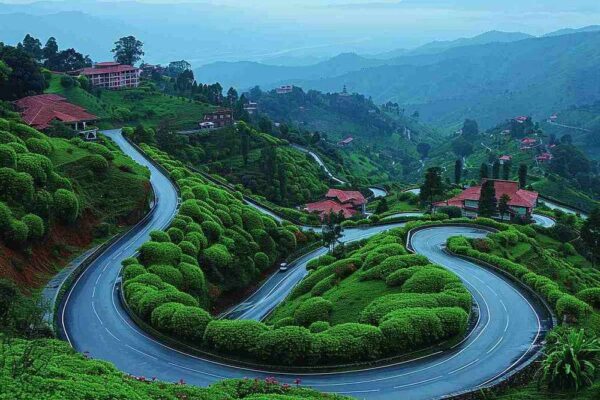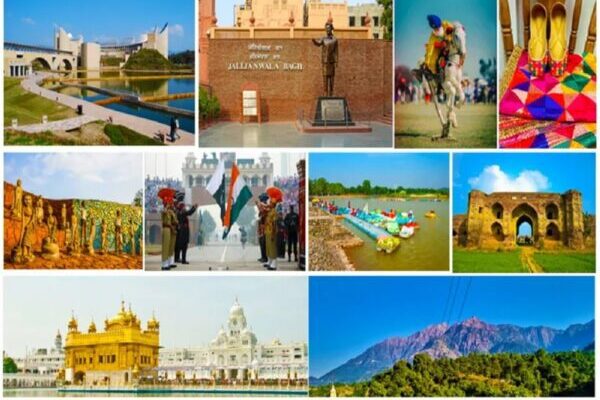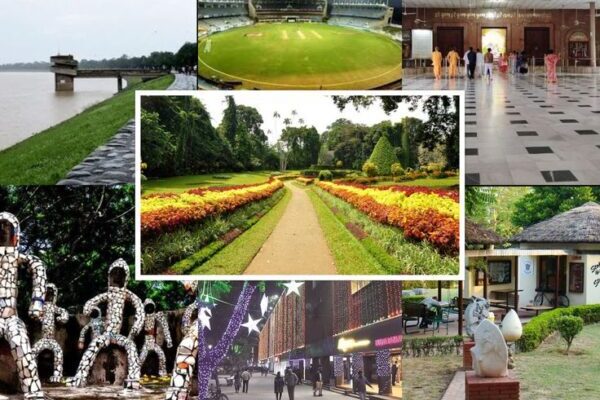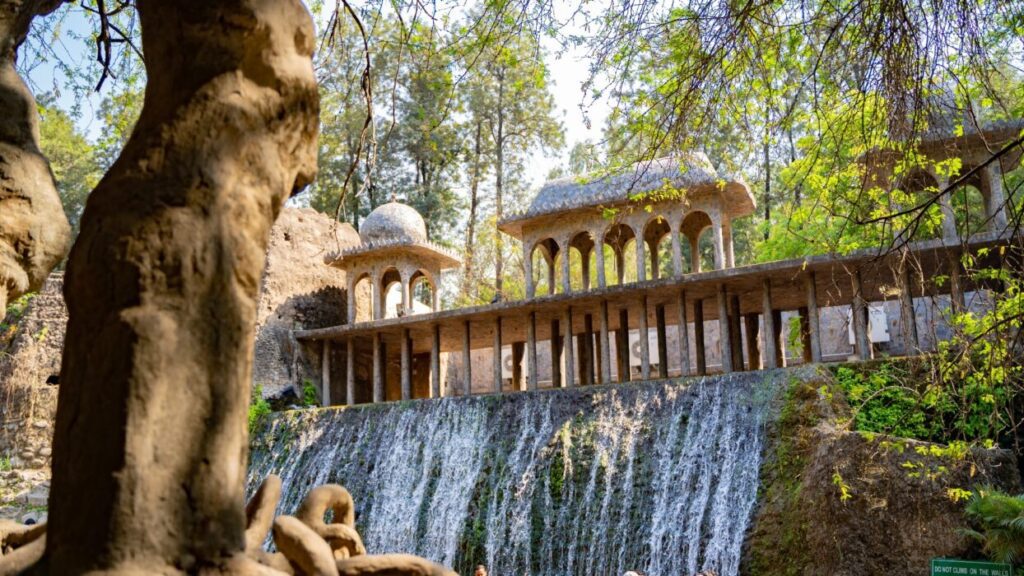05 Day(s) 04 Night(s)

central India
Known as India’s heartland, central India is a plateau region abundant in natural resources, forests, and the majestic Narmada River and its two hill ranges, the Vindhya and the Satpura. The region is filled with Majestic forts, beautiful ancient temples, grand palaces, numerous wildlife sanctuaries, magnificent monuments and spiritual sites, all of which are bursting with its vibrant culture and rich historical heritage.
The Central region of India consists of the Indian states of Madhya Pradesh and Chhattisgarh. It shares borders with Uttar Pradesh in the North, Jharkhand and Orissa in the East, Maharashtra and Telangana in the South, Rajasthan and Gujarat in the West.
Several significant dynasties have reigned over Central India, from the Chandelas and Mughals to the Marathas, Chandelas, Bundelas, and lastly the British. The land glows with the grandeur of wars fought and won, bright instances of bravery, valor, and jauhars, as well as long intriguing romance stories.
A Quick Facts About North India:-
| Total States in Central Region of India | 2 |
| Land Area in Central Region of India | 443,444 Sq. Kms. |
| Largest State of Central Region of India (in terms of Population) | Madhya Pradesh |
| Largest State of Central Region of India (in terms of Area) | Madhya Pradesh (covering 308,252 Sq. Kms) |
| Largest City in Central Region of India | Indore |
| Chhattisgarh Foundation Day | 1st November 2000 |
| Popular Places of Tourist Interest in Central Region of India | Religious, Cultural & Heritage, National Parks, Nature, and Festivals |
The culinary tapestry of Central India is woven with rich tastes and renowned dishes, each of which tells a story of tradition and creativity. Dal Pithi, Mawa Bati, Bhopali Gosht Korma, Palak Puri, Chila, Bhutte ki Kees, and Dal Bafla are among the most popular cuisines in Central India.
Central India has a plethora of folk music, dance, art, and craft forms that reflect tribal heritage and rural lifestyle of the region. The most popular of folk music is Real folk songs from the Song Maria and Muria tribes. Gaur Maria, Karma, Saila, Matki, and Tertali are among the diverse tribal dances that are performed at various events. The people of this region are incredibly skilled in the arts and handcrafts. Traditional paintings, intricate items like stone carvings, bronze sculptures, oil lamps, and more, as well as handicrafts made largely of wood and bamboo.
The majority of people in Central India are from tribal communities, although there are also Christians, Muslims, Buddhists, Sikhs, Jains, Parsis, and Hindus living there. The region has a dialect of Hindi and some other tribal languages. However, English is spoken in urban areas.
Central India has a remarkable combination of heritage, spirituality and nature that provides a distinctive travel experience. Madhya Pradesh is home to historic locations such as Khajuraho, Ujjain, and Sanchi, as well as wildlife reserves like Kanha and Bandhavgarh known for their Bengal tigers. Chhattisgarh enchants with its unspoiled woods, tribal culture, and natural wonders like Chitrakote Falls and Bastar Caves. The region is home to both cultural richness and natural marvels, as well as modernization and historical customs. This part of the nation also has several Ayurvedic and yoga centers.
Tourists have a wide range of options for theme-based vacations in Central India, such as wildlife, nature, cultural & heritage sites, religious sites, yoga and Ayurveda, and more. Each type of vacation shines best in a specific season. For example, Pachmarhi, Chitrakoot and Amarkantak would be at their best during the summer season, Satpura, Kanger Valley and Chitrakote would be at their best during the monsoon season. Gwalior, Orchha, Khajuraho, Kanha, Bandhavgarh and other areas, on the other hand, would be at their most beautiful during the winter.
Central India features numerous fairs and festivals, each with its own customs and celebrations. The Khajuraho Dance Festival is a well-known festival that showcases traditional Indian dance styles. Other significant festivals in the region are the Ujjain Kumbh Mela, Rajim Lochan Mahotsav, Bhagoria Festival, Bastar Dussehra, Malwa Utsav, Nimar Utsav, Pachmarhi Utsav, and Chethiyagiri Vihara Festival.
Transportation in Central India provides a variety of alternatives to meet each traveler’s preferences. Central India transport offers diverse options to suit every traveler’s preference. The Major cities of the central part of India like Bhopal, Indore, Khajuraho and Jabalpur are well served by domestic airports. Being the center of India, this region has an extensive railway and roadway networks that connect it to other parts of the country. Travellers can easily reach their desired destinations through State-Run and Private buses, local taxis/cabs and personal vehicles.


TOUR PACKAGES OF CENTRAL INDIA
FAQ
FAQ
Q: What is the best time to visit Central India ?
A: The ideal time to visit Central India is between October and March, when the weather is cool and pleasant, making it perfect for both sightseeing and wildlife safaris.
| Months | Season | Best for |
| October to March | Winter | Sightseeing, wildlife safaris, and exploring heritage sites |
| April to June | Summer | Wildlife spotting, especially tigers |
| July to September | Monsoon | Experiencing lush greenery and refreshed landscapes |
Q: How many days are needed to explore Central India?
A: A trip of about 7 to 10 days is ideal to explore Central India, covering major heritage sites such as Khajuraho, Orchha, Gwalior, and Sanchi, along with a wildlife safari in Kanha or Bandhavgarh. To include scenic destinations like Pachmarhi, Bhedaghat, or Chitrakote Falls, plan for 12 to 14 days. While a week is enough for the highlights, two weeks provide a more immersive experience of the region.
Q: What are the must visit places in Central India?
A: Must-visit places include Khajuraho, Orchha, Gwalior, and Sanchi for history and culture, and Kanha, Bandhavgarh, and Pench for wildlife safaris. Scenic gems like Pachmarhi, Bhedaghat’s marble rocks, and Chitrakote Falls add to its charm.
Q: What are the best places to visit during the winters in Central India?
A: The best places to visit in Central India during the winter include heritage and cultural sites like Gwalior, Orchha, Khajuraho, Mandu, Sachi and Ujjain; enjoy wildlife at Kanha, Pench and Bandhavgarh National Park; and relax in the hill station of Panchmarhi.
Q: What are the best places to visit during the summers in Central India?
A: The best places to visit during the summers in Central India include Pachmarhi hill station, a refreshing escape with waterfalls and scenic landscapes, and Amarkantak, a peaceful spiritual retreat surrounded by forests. Wildlife lovers can also explore Bandhavgarh and Kanha National Parks, where the hot season improves chances of spotting tigers near waterholes.
Q: What are the best places to visit during the monsoons in Central India?
A: The best places to visit in Central India during the monsoons include Pachmarhi hill station, renowned for its misty landscapes, and Bhedaghat near Jabalpur, famous for the Narmada River and Dhuandhar Falls. Nature lovers can also explore the rejuvenated forests of Satpura and Pench National Parks, which become especially vibrant in the rains.
Q: What are the most visited tourist attractions in Central India?
A: The most visited tourist attractions in Central India showcase a blend of heritage, wildlife, and natural beauty. Notable destinations include:-
- Khajuraho (Madhya Pradesh): UNESCO-listed temples with exquisite carvings.
- Orchha and Gwalior (Madhya Pradesh): Majestic forts, palaces, and historic cenotaphs.
- Sanchi (Madhya Pradesh): Ancient Buddhist stupas and monuments.
- Kanha, Bandhavgarh, and Pench National Parks (Madhya Pradesh): Renowned for tiger safaris and diverse wildlife.
- Pachmarhi (Madhya Pradesh): Hill station featuring waterfalls, caves, and scenic viewpoints.
- Bhedaghat (Jabalpur district, Madhya Pradesh): Famous for marble rocks and the Dhuandhar Falls on the Narmada River.
- Chitrakote Falls (Chhattisgarh): Often called the “Niagara of India”.
Q: What are some popular activities to do in Central India?
A: Some popular activities travellers and tourist can do in Central India are:-
- Wildlife Safari at Kanha, Bandhavgarh and Pench National Park
- Exploring UNESCO World Heritage Sites
- Experience scenic beauty at Pachmarhi, Bhedaghat, and Chitrakote Falls.
- Embark on spiritual journeys to Ujjain, Amarkantak, and Maheshwar
- Immerse in local culture and handicrafts in towns like Chanderi and Maheshwar
- Enjoy Cultural festivals like Khajuraho Dance Festival
Q: Which is the best wildlife destination to explore in Central India?
A: Kanha National Park stands out as the best wildlife destination in Central India, renowned for its scenic landscapes, rich biodiversity, and exceptional opportunities to spot tigers and barasinghas in the wild.
Q: What are some popular historical sites in Central India?
A: Some popular historical sites include Khajuraho temples, Orchha’s palaces and cenotaphs, Gwalior Fort, Sanchi Stupa, and the architectural marvel of Mandu.
Q: Are there any hidden gems or offbeat destinations in Central India?
A: Yes, Central India has several hidden gems and offbeat destinations that are less crowded yet equally enchanting, from Chanderi’s forts and handwoven sarees to Maheshwar’s riverside charm and Ahilya Fort. Nature lovers can explore the mystical Patalkot Valley or the serene Amarkantak, source of the Narmada River. For adventure, Kanger Valley National Park in Chhattisgarh offers caves, waterfalls, and untouched forests.
Q: Are there cultural attractions in Central India?
A: Yes, Central India boasts a vibrant cultural heritage, featuring Khajuraho’s UNESCO-listed temples, the historic palaces of Orchha and Gwalior, and the ancient Sanchi Stupa. Towns like Chanderi and Maheshwar highlight traditional handwoven sarees and crafts, while Ujjain provides rich spiritual experiences and historic temples.
Q: What are some of the most popular tourist circuits in Central India?
A: Some of the most popular tourist circuits in Central India are:-
- Heritage Circuit (Khajuraho-Orchha-Gwalior-Mandu-Sanchi-Bhimbetka)
- Spiritual Circuit (Ujjain-Omkareshwar-Panchmarhi-Amarkantak)
- Wildlife Circuit (Kanha-Bandhavgarh- Pench)
- Bhopal-Bhimbetka-Sanchi-Udayagiri Circuit
Q: Are there any UNESCO World Heritage Sites situated in Central India?
A: Yes, Central India is home of multiple UNESCO World Heritage Sites:
- Khajuraho Group of Monuments
- Sanchi Stupa
- Rock Shelters of Bhimbetka
Q: What are some lesser-known but interesting places to visit in Central India?
A: Lesser-known yet captivating destinations in Central India include Mandu (MP), famed for its Afghan-era architecture and romantic tales, and Burhanpur, noted for its Mughal monuments and textile traditions. Tamia and Patalkot Valley (MP) or Achanakmar Wildlife Sanctuary (Chhattisgarh) are perfect for nature enthusiasts. Those seeking spirituality can visit Sirpur, an ancient Buddhist hub, or Amarkantak, the sacred source of the Narmada. For its vibrant tribal culture and majestic waterfalls, the Bastar region of Chhattisgarh stands out as a true hidden treasure.
Q: What are popular things to buy in Central India?
A: Central India is renowned for its vibrant textiles, traditional crafts, and unique tribal artistry. Here are some of the most popular things to buy when visiting the region:-
- Textiles & weaves: Maheshwari sarees, Chanderi saree and Batik print
- Handicrafts and Tribal art: Terracotta & bell metal craft, Bastar Dhokra, Gond paintings and tribal Jewelry
- Stone and Wood work: Jabalpur Marble items and Bastar Wooden Work like masks, furniture and carved home decor
- Food And Species: Tribal herbal products and forest produce and Namkkens and sweets from Indore.
Q: Which Central Indian cuisine should travellers and tourists try?
A: Travellers in Central India should try Indore’s street food like poha–jalebi and bhutte ka kees, or Bhopal’s rich Mughlai fare like kebabs and rogan josh. For an authentic rustic taste, Chhattisgarh’s tribal delicacies such as chila, faraa, and aamat are highly recommended. Together, these dishes create a flavorful mix of tradition, spice, and culture.
Q: Is Central India Safe for solo travellers including women?
A: Central India is largely safe for solo travellers, including women, particularly in well-known cities and tourist destinations like Bhopal, Indore, Khajuraho, and Pachmarhi. It’s wise to take basic precautions—avoid isolated areas after dark, dress modestly in rural regions, and rely on trusted transportation. Most tourist circuits are regularly visited, making independent travel comfortable and manageable.
Q: What should travellers pack for a trip to Central India?
A: Travellers visiting Central India should pack according to season, terrain, and type of activities planned, and local cultural norms in mind.
- Clothing:
- Light and breathable clothes
- Light Jacket
- Shawl or Scarf
- Footwear:
- Comfortable sandals or Flip-flop
- Sun Protection:
- Sunglasses
- Sunscreen
- Hat
- Health and Hygiene:
- Personal medication
- Personal care products
- Hand Sanitizer
- Mosquito repellent
- Travel Documents and Money:
- Passport and Visa
- ID Copies
- Travel Insurance
- Local Currency
- Other important documents
- Electronics:
- Power Bank
- Travel adapter
- Camera and extra memory cards
- Miscellaneous:
- Reusable water bottle
- Raincoat and Umbrella
- Reusable shopping bags
Q: Is it easy to get around Central India cities using public transport?
A: Getting around cities in Central India is generally quite convenient with public transport. Major urban centers like Bhopal, Indore, and Raipur provide buses, auto-rickshaws, and app-based cab services. While trains and intercity buses link popular tourist spots, reaching rural areas often requires taxis or private vehicles.
Q: What should travellers and tourists wear when visiting temples and religious sites of Central India?
A: Travellers visiting temples in Central India should dress modestly, ensuring their shoulders and knees are covered. Comfortable, breathable clothing is ideal, and shoes should be easy to take off to honor local traditions.
Q: Is WiFi readily available in Central India?
A: WiFi is commonly accessible in major cities and tourist areas of Central India, such as Bhopal, Indore, and Raipur, as well as in hotels, cafes, and certain public areas. However, in rural regions, small towns, and remote destinations, connectivity can be limited or slower, making mobile data a more reliable option for travellers.
Q: Can travellers and tourists easily get a local SIM card in Central India?
A: Yes, travellers can easily obtain a local SIM card in Central India at airports, mobile outlets, and authorized stores in cities such as Bhopal, Indore, and Raipur. Foreign visitors require a valid passport and visa, and activation generally takes a few hours.
Q: Where can travellers and tourists exchange currency in Central India?
A: Travellers can exchange currency in Central India at banks, authorized money exchange centers, airports, and some hotels in major cities like Bhopal, Indore, and Raipur. It’s advisable to use official channels to ensure safety and fair exchange rates.
Q: Where can travellers and tourists find ATMs in Central India?
A: ATMs are widely available in Central India, especially in major cities and towns like Bhopal, Indore, and Raipur, as well as near markets, shopping areas, and tourist spots. However, in rural or remote areas, ATM access may be limited, so carrying some cash is recommended.
Q: Are credit cards widely accepted in Central India?
A: Credit cards are widely accepted in major cities and at hotels, restaurants, and shopping centers in Central India, especially in Bhopal, Indore, and Raipur. In contrast, rural areas, small shops, and local markets often prefer cash, so it’s wise to carry some Indian currency.
Q: What cultural customs should travellers and tourists know before travelling to Central India?
A: Travellers visiting Central India should be aware of local customs to show respect and ensure a pleasant experience:
- Greetings & Respect: A traditional “Namaste” is appreciated; avoid physical contact with elders or religious figures unless invited.
- Dress Modestly: Cover shoulders and knees, especially in temples, mosques, and tribal villages.
- Shoes & Cleanliness: Remove footwear before entering homes, temples, and certain public areas.
- Photography Etiquette: Seek permission before photographing people, especially in tribal communities.
- Festivals & Rituals: Observe local festivals and rituals respectfully, without interrupting ceremonies.
- Food Customs: Many sites are vegetarian-friendly; avoid wasting food and respect local dining traditions.






